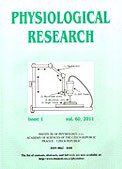Ošťádalová I, Charvátová Z, Wilhelm J. Physiol Res. 2010 59(6):881–6. IF: 2.575

Abstract:
The aim of the study was to characterize a) the lipofuscin-like pigment (LFP) accumulation (an indicator of ROS production) in the rat heart during early postnatal period and b) possible antioxidative role of selenium. Experimental animals received Na2SeO3 in drinking water during gravidity and up to day 15 post partum. Two fluorophores of LFP in the hearts of 1-, 4-, 7- and 15-day-old rats were evaluated by fluorescent analysis. The highest level of heart/body weight ratio in control rats was observed on day 4, in the Se-supplemented rats on day 7. Cardiac LFP content in controls increased from postnatal day 4, in the hearts of Se-supplemented rats the LFP content increased already from day 1. As compared with the Se-supplemented group the LFP content of control hearts was significantly higher on day 1 but significantly lower on day 4. LFP concentration in control hearts decreased from postnatal day 1 to 4; this decrease was followed by significant increase until day 7 and decrease to day 15. LFP concentration in the Se-supplemented hearts was the highest on postnatal day 7; it differed from controls on day 1 and 4. Significant changes of LFP suggest an important role of ROS during critical ontogenetic period.
-az-
